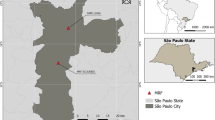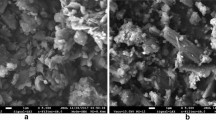Abstract
In the vulnerable Arctic environment, the impact of especially hazardous wastes can have severe consequences and the reduction and safe handling of these waste types are therefore an important issue. In this study, two groups of heavy metal containing particulate waste materials, municipal solid waste incineration (MSWI) fly and bottom ashes and mine tailings (i.e., residues from the mineral resource industry) from Greenland were screened in order to determine their suitability as secondary resources in clay-based brick production. Small clay discs, containing 20 or 40% of the different particulate waste materials, were fired and material properties and heavy metal leaching tests were conducted before and after firing. Remediation techniques (washing in distilled water and electrodialytical treatment) applied to the fly ash reduced leaching before firing. The mine tailings and bottom ash brick discs obtained satisfactory densities (1669–2007 kg/m3) and open porosities (27.9–39.9%). In contrast, the fly ash brick discs had low densities (1313–1578 kg/m3) and high open porosities (42.1–51. %). However, leaching tests on crushed brick discs revealed that heavy metals generally became more available after firing for all the investigated materials and that further optimisation is therefore necessary prior to incorporation in bricks.



Similar content being viewed by others
References
Alonso-Santurde R, Andrés A, Viguri JR, Raimondo M, Guarini G, Zanelli C, Dondi M (2011) Technological behaviour and recycling potential of spent foundry sands. J Environ Manag 92:994–1002
Askaer L, Schmidt LB, Elberling B, Asmund G, Jónsdóttir IS (2008) Environmental impact on an arctic soil-plant system resulting from metals released from coal mine waste in Svalbard (78° N). Water Air Soil Pollut 195:99–114. doi:10.1007/s11270-008-9730-z
Belmonte LJ (2015) Use of Greenlandic resources for the production of bricks. Unpublished PhD thesis, Technical University of Denmark.
Bertelsen IMG, Belmonte LJ, Chen W, Ottosen LM (2015) Properties of bricks produced from Greenlandic marine sediments. In: Proceedings of the 23rd International Conference on Port and Ocean Engineering Under Arctic Conditions. Trondheim, Norway
Bloodworth A, Highley D, Lusty P (2007) Brick clay—mineral planning factsheet, British Geological Survey
Brick Industry Association (2006) Manufacturing of brick—technical notes on brick construction 9. Reston, Virginia, USA
Chen Y, Zhang Y, Chen T, Zhao Y, Bao S (2011) Preparation of eco-friendly construction bricks from hematite tailings. Constr Build Mater 25:2107–2111. doi:10.1016/j.conbuildmat.2010.11.025
Colombo P, Brusatin G, Bernardo E, Scarinci G (2003) Inertization and reuse of waste materials by vitrification and fabrication of glass-based products. Curr Opin Solid State Mater Sci 7:225–239. doi:10.1016/j.cossms.2003.08.002
Danish Ministry of the Environment (Miljøministeriet) (2012) BEK 1309: Bekendtgørelse om affald
Danish Ministry of the Environment (Miljøministeriet) (2015) BEK 1414: Bekendtgørelse om anvendelse af restprodukter og jord til bygge- og anlægsarbejder og om anvendelse af sorteret, uforurenet bygge- og anlægsaffald
Danish Technological Institute (1983) Prøvningsmetode Bestemmelse af kapillær vandmætningsgrad Prøvningsmetode Bestemmelse af kapillær vandmætningsgrad
DIN 18122-1 (1997) Baugrund, Untersuchung von Bodenproben—Zustandsgrenzen (Konsistenzgrenzen)—Teil 1: Bestimmung der Fließ- und Ausrollgrenze
Doherty R (1996) Social, economic and technical links between northern regions of Canada and Russia. In: Lyck L, Boyko VI (eds) Management, technology and human resources policy in the Artic (The North): Proceedings of the NATO Advanced Research Workshop, Novosibirsk 1995. Kluwer Academic Publishers, p 19–30
Domíngues E, Dondi M, Iglesias C (2012) Environmental suitability of ceramic raw materials: a geochemical approach to volatile emissions and leaching potentials. Environ Earth Sci 65:517–523
Dondi M, Marsigli M, Fabbri B (1997) Recycling of Industrial and urban wastes in brick production: a review. Tile brick Int. 13:218–225 and 302–315
Dondi M, Principi P, Raimondo M, Zanarini G (2000) Conduttività termica dei laterizi ottenuti con argille italiane (the thermal conductivity of bricks produced with Italian clays). L’industria dei Laterizi 65:309–320
Dondi M, Mazzanti F, Principi P, Raimondo M, Zanarini G (2004) Thermal conductivity of clay bricks. J Mater Civ Eng 16:287–287. doi:10.1061/(ASCE)0899-1561(2004)16:3(287)
DS 259 (2003) Determination of metals in water, sludge and sediments—general guidelines for determination by atomic absorption spectrophotometry in flame
DS/EN 12457-1 (2002) Characterisation of waste—leaching—compliance test for leaching of granular waste materials and sludges—part 1: one stage batch test at a liquid to solid ratio of 2 l/kg for materials with high solid content and with particle size below 4 mm (withou
DS/ISO 17380 (2005) Soil quality - determination of total cyanide and easily released cyanide - continous-flow analysis method
Eisted R, Christensen TH (2011) Waste management in Greenland: current situation and challenges. Waste Manag Res 29:1064–1070. doi:10.1177/0734242X10395421
Elberling B, Asmund G, Kunzendorf H, Krogstad EJ (2002) Geochemical trends in metal-contaminated fiord sediments near a former lead-zinc mine in West Greenland. Appl Geochemistry 17:493–502. doi:10.1016/S0883-2927(01)00119-6
European Parliament and the council of the European Union (2008) REGULATION (EC) no 1272/2008 on classification, labelling and packaging of substances and mixtures, amending and repealing Directives 67/548/EEC and 1999/45/EC, and amending Regulation (EC) No 1907/2006
Gillott JE (1979) Fabric, composition and properties of sensitive soils from Canada, Alaska and Norway. Eng Geol 14:149–172. doi:10.1016/0013-7952(79)90082-6
Hjelmar O, Johnson A, Comans R (2011) Incineration: solid residues. In: Christensen TH (ed) Solid waste technology & management. Wiley, p 430–462. doi:10.1002/9780470666883.ch29
ISO/TS 17892-12 (2004) Geotechnical investigation and testing—laboratory testing of soil—part 12: determination of Atterberg limits
Johansen P, Asmund G (2001) Pollution from mining in greenland—a review. In: Olsen HK, Lorentzen L, Rendal O (eds) Mining in the arctic. Proceedingsof the Sixth International Symposium on Mining in the Arctic, Nuuk, Greenland, 28–31 May 2001. A.A.Balkema Publishers, p 29–35
Karius V, Hamer K (2001) pH and grain-size variation in leaching tests with bricks made of harbour sediments compared to commercial bricks. Sci Total Environ 278:73–85
Kasuriya S, Jiemsirilers S, Thavorniti P (2008) Effect of MSW incineration bottom ash in clay based ceramics. Mater Sci Forum 569:205–208. doi:10.4028/www.scientific.net/MSF.569.205
Kirkelund, G.M., Joergensen, A.S., Ingeman-Nielsen, T., Villumsen, A., 2012. Characterisation of MSWI bottom ash for potential use as subbase in Greenlandic road construction, in: 4th International Conference on Engineering for Waste and Biomass Valorisation (wasteeng12). Porto, Portugal, p 835–840.
Kirkelund GM, Jensen PE, Ottosen LM (2013) Electrodialytic extraction of heavy metals from greenlandic MSWI Fly Ash as a function of remediation time and L/S ratio. In: ISCORD 2013 (ed) Planning for sustainable cold regions—Proceedings of the 10th International Symposium on Cold Regions Development. Anchorage, Alaska, USA, p 87–96
Kirklund GM, Jensen PE, Villumsen A, Ottosen LM (2010) Test of electrodialytic upgrading of MSWI APC residue in pilot scale: focus on reduced metal and salt leaching. J App Electrohem 40:1049–1060. doi:10.1007/s10800-009-0059-0
Lemly AD (1994) Mining in northern Canada: expanding the industry while protecting arctic fishes—a review. Ecotoxicol Environ Saf 29:229–242. doi:10.1016/0147-6513(94)90022-1
Lewis A (1984) New Inco Tech process attacks toxic cyanides. Eng Min J 185(7):52–54
Locat J, St-Gelais D (2014) Nature of sensitive clays from Québec. In: L’Heureux JS, Locat A, Leroueil S, Demers D, Locat J (eds) Landslides in sensitive clays: from geosciences to risk management. Springer, p 25–37
Locat J, Lefebvre G, Ballivy G (1984) Mineralogy, chemistry, and physical properties interrelationships of some sensitive clays from Eastern Canada. Can Geotech J 21:530–540
Lorber KE, Antrekowitsch H (2011) Disposal ponds and tailing dams. Waste Manag Res 29:125–126. doi:10.1177/0734242X11398643
Lottermoser BG (2007) Mine wastes, mine wastes (second edition): characterization, treatment, environmental impacts. Springer Verlag, Berlin Heidelberg. doi:10.1007/978-3-540-48630-5
Menezes RR, Ferreira HS, Neves GA, Lira H d L, Ferreira HC (2005) Use of granite sawing wastes in the production of ceramic bricks and tiles. J Eur Ceram Soc 25:1149–1158. doi:10.1016/j.jeurceramsoc.2004.04.020
Mezencevova A, Yeboah NN, Burns SE, Kahn LF, Kurtis KE (2012) Utilization of Savannah Harbor river sediment as the primary raw material in production of fired brick. J Environ Manag 113:128–136. doi:10.1016/j.jenvman.2012.08.030
Moiseenko TI (1999) The fate of metals in Arctic surface waters: method for defining critical levels. Sci Total Environ 236:19–39. doi:10.1016/S0048-9697(99)00280-6
Poland JS, Riddle MJ, Zeeb BA (2003) Contaminants in the Arctic and the Antarctic: a comparison of sources, impacts, and remediation options. Polar Rec (Gr Brit) 39:369–383. doi:10.1017/S0032247403002985
Rambaldi E, Esposito L, Andreola F, Barbieri L, Lancellotti I, Vassura I (2010) The recycling of MSWI bottom ash in silicate based ceramic. Ceram Int 36:2469–2476. doi:10.1016/j.ceramint.2010.08.005
Ramesh R, D’Anglejan B (1995) Mineralogy, chemistry and particle size interrelationships in some post-glacial marine deposits of the St. Lawrence Lowlands J Coast Res 11:1167–1179
Ramirez-Llodra E, Trannum HC, Evenset A, Levin LA, Andersson M, Finne TE, Hilario A, Flem B, Christensen G, Schaanning M, Vanreusel A (2015) Submarine and deep-sea mine tailing placements: a review of current practices, environmental issues, natural analogs and knowledge gaps in Norway and internationally. Mar Pollut Bull 97:13–35. doi:10.1016/j.marpolbul.2015.05.062
Reid C, Bécaert V, Aubertin M, Rosenbaum RK, Deschênes L (2009) Life cycle assessment of mine tailings management in Canada. J Clean Prod 17:471–479. doi:10.1016/j.jclepro.2008.08.014
Riley CM (1951) Relation of chemical properties to the bloating of clays. J Am Ceram Soc 34:121–128
Roaldset E (1972) Mineralogy and geochemistry of quaternary clays in the Numedal area, southern Norway. Nor Geol Tidsskr 52:335–369
Rosenqvist IT (1975) Origin and mineralogy glacial and interglacial clays of southern Norway. Clay Clay Miner 23:153–159. doi:10.1346/CCMN.1975.0230211
Roy S, Adhikari GR, Gupta RN (2007) Use of gold mill tailings in making bricks: a feasibility study. Waste Manag Res 25:475–482. doi:10.1177/0734242X07076944
Rylander C, Odland JØ, Sandanger TM (2011) Climate change and environmental impacts on maternal and newborn health with focus on Arctic populations. Glob. Health Action 4:1–11. doi:10.3402/gha.v4i0.8452
Schlatter DM, Olsen SD (2011) The Nalunaq gold mine: a reference sample collection and compilation and interpretation of geochemical data. Danmarks og Grønlands Geologiske Undersøgelse Rapport. 2011/31
Secher K, Stendal H, Stensgaard BM (2008) The Nalunaq gold mine. Geol. Ore—Explor. Min. Greenl. 11:1–12
Segadães AM, Carvalho MA, Acchar W (2005) Using marble and granite rejects to enhance the processing of clay products. Appl Clay Sci 30:42–52. doi:10.1016/j.clay.2005.03.004
Sorensen H (2001) The Ilímaussaq alkaline complex, South Greenland: status of mineralogical research with new results. Geol Greenl Surv Bull 190:7–23
Steenfelt A (2000) Geochemical signatures of gold provinces in South Greenland. Appl Earth Sci 109:14–22. doi:10.1179/aes.2000.109.1.14
Stendal H, Secher K (2002) Gold mineralisation and gold potential in South Greenland. Geol Ore—Explor Min Greenl 1:1–12
Torres P, Fernandes HR, Olhero S, Ferreira JMF (2009) Incorporation of wastes from granite rock cutting and polishing industries to produce roof tiles. J Eur Ceram Soc 29:23–30. doi:10.1016/j.jeurceramsoc.2008.05.045
Worrall WE (1975) Clays and ceramic raw materials. Applied science publishers Ltd, London
Zhang L (2013) Production of bricks from waste materials—a review. Constr Build Mater. doi:10.1016/j.conbuildmat.2013.05.043
Zhang HY, Zhao YC, Qi JY (2007) Study on use of MSWI fly ash in ceramic tile. J Hazard Mater 141:106–114. doi:10.1016/j.jhazmat.2006.06.100
Zhang HY, Zhao YC, Qi JY (2011) Utilization of municipal solid waste incineration (MSWI) fly ash in ceramic brick: product characterization and environmental toxicity. Waste Manag 31:331–341. doi:10.1016/j.wasman.2010.10.017
Acknowledgements
This project was funded by the Government of Greenland, DTU Civil engineering and the Danish Agency for Science, Technology and Innovation. Louise Belmonte wishes to thank Angel Mining Plc. and Kurt Christensen for the opportunity to visit the Nalunaq gold mine and for help and assistance during the stay and with collecting the tailings samples. The authors wish to thank Tanbreez Mining Greenland A/S for providing the Tanbreez tailings.
Author information
Authors and Affiliations
Corresponding author
Additional information
Responsible editor: Philippe Garrigues
Rights and permissions
About this article
Cite this article
Belmonte, L.J., Ottosen, L.M., Kirkelund, G.M. et al. Screening of heavy metal containing waste types for use as raw material in Arctic clay-based bricks. Environ Sci Pollut Res 25, 32831–32843 (2018). https://doi.org/10.1007/s11356-016-8040-z
Received:
Accepted:
Published:
Issue Date:
DOI: https://doi.org/10.1007/s11356-016-8040-z




